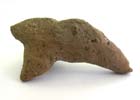Clay figurines, mostly zoomorphic or in simplified animal-like forms, were frequently recovered. A few fragments of small anthropomorphic figurines are also present. There are also a large number of small irregular lumps of clay which were simply shaped by pinching.
Different types of beads were made of various kinds of stones and clay. Clay beads are often in a shape of a flat barrel with narrow ends and a wide body. Of note is that a bead made of native copper, as well as a few pieces of copper ore or unworked malachite, were recovered. The copper bead was produced by coiling native copper which was hammered into a flat band.
Bone tools, such as awls and spatulas, are also common as well as flat spindle whorls made of stones. The contexts in which small finds were recovered are in most cases not associated with any solid structures. However, the Str.166 building, which contains seven child burials, yielded an exceptionally large number of small finds, including two clay beads, a simplified animal figurine, a polished axe, a spindle whorl, a handstone, a bone awl, a bone spatula and a bone bead.
